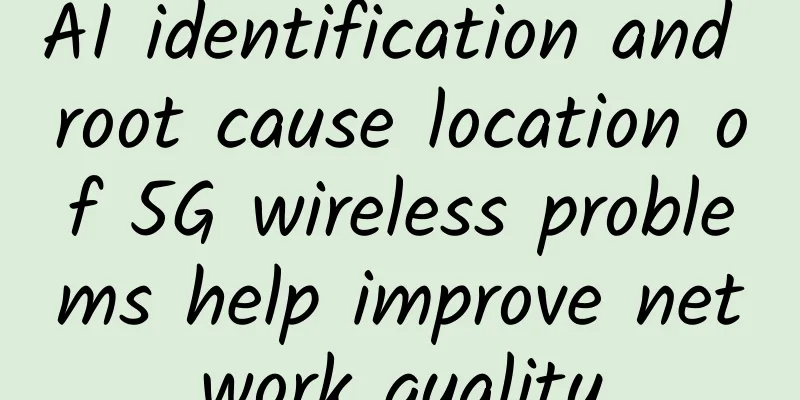AI identification and root cause location of 5G wireless problems help improve network quality

|
Author: Zhang Zhe and Chen Juanjuan, unit: Hebei Mobile Labs GuideSince the Ministry of Industry and Information Technology officially issued 5G commercial licenses, my country has entered the 5G era. Hebei Mobile has actively invested in network construction and promoted the development of 5G commercial networks. The large-scale investment in 5G base stations is accompanied by a series of wireless network quality and customer satisfaction issues. We are currently in the stage of stabilizing 4G and expanding 5G, so how to reduce the burden, efficiently and accurately solve problems has become a key challenge. Against the backdrop of increasing complexity of 5G networks and complex scenario-based pattern combinations, the requirements for optimization personnel's capabilities are gradually increasing. This requires the accumulation and iteration of experts' optimization experience and the gradual realization of tool intelligence. Hebei Mobile has established a VoNR evaluation system by governing wireless performance, alarms and MR data, and used AI prediction capabilities to accurately identify network problems. It has also built a rule engine module to determine the wireless root cause of problems, realizing the ability to identify wireless problems and intelligently analyze them, effectively improving the accuracy of 5G network problem identification and problem handling efficiency, helping to improve the quality of 5G networks and create a high-quality image and reputation for 5G networks. 1. Technical Solution Introduction1.1 Data GovernanceData governance uses asset catalogs, model stratification, permission management, and model management to precipitate and summarize performance, alarm, and MR data on the O-domain platform, allowing for quick viewing and call-up when in use. 1.2 VoNR Evaluation SystemAfter data governance, key VoNR indicators can be effectively identified, supporting the discovery of network problems in the early stage of VoNR commercialization, achieving end-to-end perception improvement of VoNR and rapid problem demarcation, and building a full-process end-to-end VoNR experience guarantee system based on key interface association. Automatic demarcation based on expert experience library + big data analysis, automatic analysis and positioning capabilities of wireless quality-poor cells based on rule engine & customizable configuration, and root cause recommendation are established to support VoNR commercialization guarantee. A VoNR perception evaluation system is built around the dimensions of registration, access, retention, and voice quality. Key indicator trend insights, problem demarcation capabilities, and abnormal problem traceback capabilities are built based on VoNR characteristics to support network quality monitoring in VoNR commercial use and rapid discovery and demarcation of abnormal problems. 1.3 Identification of poor wireless quality issuesWireless poor quality identification sets the TOPN threshold for the registration, access and retention indicators of the VoNR evaluation system, and automatically identifies poor quality cells using the multi-data source automatic association, multi-window linkage analysis, and deep analysis based on AI algorithms of intelligent KPI anomaly detection. It also supports manual custom configuration to identify poor quality cells, which is applicable to a variety of scenarios and makes problem discovery faster and more efficient. 1.4 Root cause diagnosis and analysis1.4.1 Building rule engine capabilitiesThe delimitation rule engine provides wireless side rule management functions, and the wireless side problem delimitation and location rules can be configured flexibly and autonomously in the rule arrangement interface. The rule engine automatically integrates wireless MR, alarms, operation logs and performance indicators, can accurately locate the cause of the problem period, and supports custom arrangement rules, including creation, deletion, modification, etc., and can flexibly set rule parameter thresholds. The system provides 700+ preset rules based on expert experience. 1.4.2 Intelligent Location of Wireless Root CausesThe rule engine associates operation logs, alarms, neighboring cells, parameters, coverage, capacity, interference, transmission information, etc. to facilitate manual analysis. Based on the TOPN-identified poor wireless quality cells, the rule engine can be actively called, and the root causes can be sorted, and the key reasons for the poor wireless quality cells can be output to guide the rapid processing and closed loop of the problem. 2Technological innovations2.1 KPI Anomaly DetectionWireless KPIs have characteristics such as periodicity, volatility, and segmentation. It is difficult to solidify the monitoring threshold. If it is too low, a large number of false alarms may occur, and if it is too high, anomalies may not be detected. The static/rule thresholds used in traditional wireless network performance are difficult to fully adapt to the irregularity and diversity of performance characteristics. In addition, the network (equipment) structure in the IT and CT fields is becoming more and more complex, which leads to more and more monitoring indicators. The traditional method of setting static thresholds based on expert experience is becoming increasingly difficult to complete comprehensive monitoring of the network (equipment) and is difficult to adapt to the dynamic changes of indicators. AI-based KPI anomaly detection intelligently generates dynamic thresholds and realizes simultaneous monitoring of large-scale indicators based on the funnel principle. Through KPI anomaly detection, the anomaly perception time can be shortened from 2 hours to 30 minutes, improving the efficiency of VoNR anomaly perception detection. 2.2 Alarm Correlation and AggregationThrough KPI alarm aggregation and merging, VoNR problem clusters can be quickly identified, problem levels can be upgraded, and problems can be quickly identified and closed. Principles of KPI alarm aggregation:
Principle of KPI alarm merging: Depth-first search DFS
Based on the above analysis results in the time dimension (occurring simultaneously), space dimension (adjacent/topological), and business dimension (business-related), related alarms are merged into the same event to improve the correlation accuracy. 2.3 Card ManagementIt supports users to flexibly and intuitively design and customize dashboard display layout, indicators and granularity, and set and save personalized dashboard templates for reuse. 3 Application EffectsPositioning accuracy: The automatic diagnosis of the root cause of the problem has an accuracy rate of over 80%, of which the SA connection rate is 86.52%. Production efficiency: The processing efficiency of VoNR top cells with poor wireless quality has been increased from 13 per person-day to 20 per day, a 50% increase in efficiency. The analysis cycle of all top cells has been increased from weeks to days. Improved workflow efficiency: The workflow efficiency has been significantly improved, with the end-to-end efficiency of problem handling increasing by approximately 35.83%. The analysis workflow has changed. Compared with the traditional analysis process, data collection and VoNR top N identification processes are omitted, and root cause analysis and optimization suggestions are output more quickly. |
<<: Industry 4.0 drives the need for 5G and private networks in the enterprise
>>: Interview surprise: Why does TCP need a three-way handshake?
Recommend
The history of the changes in Spring Festival Gala red envelopes: Why are Internet giants rushing to appear on the Spring Festival Gala?
The Spring Festival is getting closer and closer,...
Quick Start with Linkerd v2 Service Mesh
In this guide, we'll walk you through how to ...
Five-minute technical talk | HTTP evolution history
Part 01 Protocol Introduction HTTP is the most po...
Maipu attended the 3rd China Military-Civilian Integration Technology and Equipment Expo
[51CTO.com original article] Recently, the 3rd Ch...
5G small base stations are expected to usher in great development to help 5G empower thousands of industries
As my country's 5G outdoor continuous coverag...
Leading the new trend of the trillion-dollar cloud video market, Huichang Communication was successfully listed on the Growth Enterprise Market
On January 25, 2017, Shanghai Huichang Communicat...
Wireless technology is gradually becoming an important direction for network development and application in the future industrial Internet
Germany's "Industry 4.0 R&D White Pa...
Changchun Municipal Government Signs Strategic Cooperation Agreement with Huawei Cloud Computing Data Center
On the afternoon of March 31, the Changchun Munic...
At the Huawei Maimang 8 launch event, He Gang of Huawei said that the greater the challenge, the greater the achievement
At the launch of Huawei Maimang 8 mobile phone, t...
"IPv6+" builds intelligent connections in all scenarios and supports the digital future
On August 28, the 2020 China IPv6 Development For...
10gbiz: $3.58/month KVM-1GB/30GB/15M unlimited/Los Angeles data center
10gbiz is a newly opened foreign hosting service ...
How 5G will benefit the Internet of Things
In this article, we want to turn our attention to...
Want to save power on your 5G phone? Wake it up first!
With the development of 5G networks, everyone has...
Bluetooth: "You have joined the group chat"
Have you ever wondered how mobile phones, headpho...
Why do we need a websocket protocol when there is an HTTP protocol?
Usually when we open a web page, such as a shoppi...









